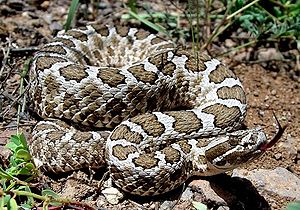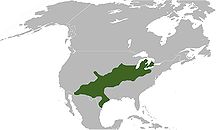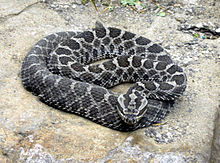Massassauga
| Massassauga | ||||||||||||
|---|---|---|---|---|---|---|---|---|---|---|---|---|

Massassauga ( Sistrurus catenatus ) |
||||||||||||
| Systematics | ||||||||||||
|
||||||||||||
| Scientific name | ||||||||||||
| Sistrurus catenatus | ||||||||||||
| ( Rafinesque , 1818) |
The Massassauga ( Sistrurus catenatus ), also known as the chain rattlesnake , is a species of the dwarf rattlesnake ( Sistrurus ) that is found in a wide strip across the central United States of America from southern Ontario , Canada , to northern Mexico .
features
The Massassauga reaches an average body length of about 50 centimeters and is rarely up to one meter long, making it the largest species of dwarf rattlesnake and also larger than many Mexican rattlesnakes (genus Crotalus ). The basic color of the snake is usually brown or gray with a pattern of easily recognizable dark or chestnut brown spots on the back. There is a noticeable pair of spots on the nape of the neck and a band on the temples extends from the muzzle over the eyes to the corners of the mouth. Melanistic individuals with a high proportion of black color pigments can occur especially in the north of the distribution area .
distribution and habitat
The Massassauga is distributed in a wide strip across the central United States of America from southern Ontario , Canada , to northern Mexico , southeastern Arizona and Texas . In Mexico there are also two isolated populations in the states of Nuevo León and Coahuila .
A number of different habitats are used as living space. In the north, the species prefers swampy forest areas, while in the southern part of the range it is mainly found in grasslands.
Systematics
The Massassauga is currently split into three subspecies:
- S. c. catenatus or Eastern Massassauga in the north-eastern part of the range; it lives mainly in swamp forests and is often darker in color than the other subspecies
- S. c. edwardsi ( desert Massasauga ) in the southern areas of the distribution area including Mexico; it is smaller than the other subspecies and lives in arid areas
- S. c. tergeminus or Western Massassauga in the western part of the distribution area in the central USA and south to Texas and the Gulf of Mexico .
Snake venom
The poison of the dwarf rattlesnake corresponds in its basic composition to that of the rattlesnake and like most viper poisons it is hemotoxic, i.e. it destroys blood cells and the walls of the blood vessels. Hemotoxins lead mainly to tissue destruction, internal bleeding and swelling and are very painful, but compared to most neurotoxins they kill less quickly. In contrast to the poisons of the rattlesnakes, those of the dwarf rattlesnakes are far less well researched. The Massassauga only produces relatively small amounts of poison, the effects usually consist of local swelling, pain and general nausea .
literature
- Chris Mattison: Rattlers! - A natural history of rattlesnakes. Blandford, London 1996, ISBN 0-7137-2534-6 , pp. 134-135.
Web links
- Sistrurus catenatus in The Reptile Database
- Sistrurus catenatus onthe IUCN 2013 Red List of Threatened Species . Posted by: Frost, DR, Hammerson, GA & Santos-Barrera, G., 2007. Retrieved October 5, 2013.

